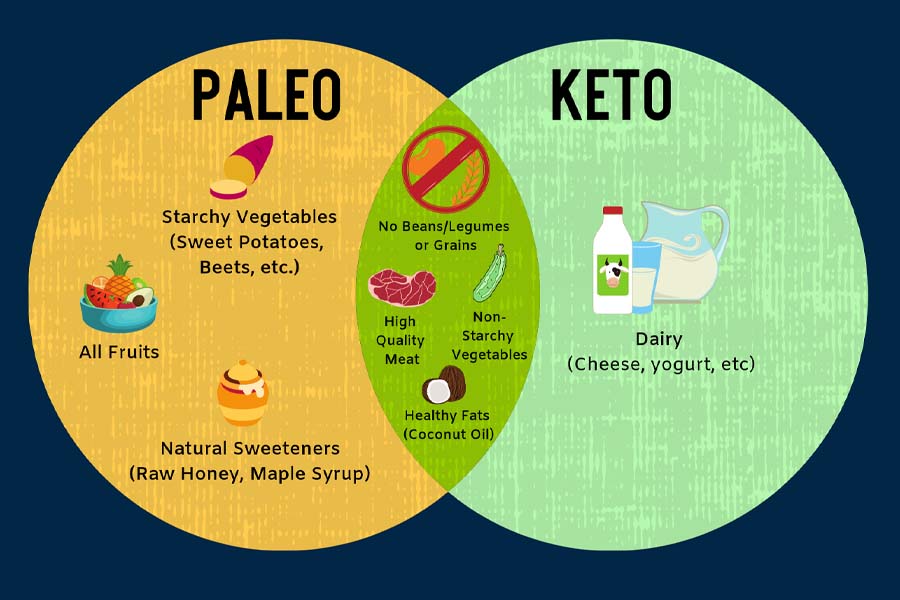The keto vs. paleo debate has been going on for quite some time. Both diets claim to be beneficial, but their differences can make it hard to decide which may be best for you. Key distinctions include the balance of macronutrients and the choice of food staples allowed on these two diets.
While the ketogenic diet calls for high-fat and low carbohydrate consumption, paleo focuses more on carbohydrates derived from animal and plant-based sources. Therefore, understanding these key distinctions is essential when formulating your nutrition plan. However, always consult with your doctor before starting any of these diets!
What Is a Keto Diet?
The ketogenic diet is a low-carbohydrate, high-fat diet that focuses on putting your body into ketosis. This means reducing the carbohydrates you consume and increasing the healthy fats you take in.
The primary goal of this diet is to induce a metabolic shift from using sugar (glucose) as its primary energy source to burning fat instead. Eating foods like meats, eggs, nuts, seeds and healthy fats like olive oil and avocados will promote this process.
Additionally, low carbohydrate intake helps ensure that your body is entering a state of ketosis and can effectively utilize stored fat for energy.
Related Article: The Keto Reboot - 7-Day Ketogenic Diet Plan for Beginners
What Is a Paleo Diet?
Paleo diets are based on eating patterns that mimic our hunter-gatherer ancestors. This diet focuses on consuming nutrient-dense whole foods such as lean meats, fish, fruits, vegetables, and nuts.
The main idea of paleo is to consume only foods available during the paleolithic era. As a result, this diet eliminates all processed and refined foods from your diet, including dairy, added sugars, and grains.
Compared to the ketogenic diet, paleo tends to be higher in carbohydrates because it incorporates some starchy vegetables like sweet potatoes, yams, and squash. It also includes more fruit than the keto diet. Additionally, while there may still be some moderate fat consumption on paleo diets, they typically emphasize protein consumption more than fats.
Now let's look at the similarities and differences between the two!
Keto Vs Paleo: What Are the Similarities and Differences
The keto and paleo diets have been trendy among people trying to improve their health. While they have some similarities, some key differences must be considered before deciding which works best for you.
Both keto and paleo diets have similar goals regarding overall health and well-being. They both promote consuming whole foods such as fruits, vegetables, lean proteins, healthy fats, and limited processed foods. Here are the similarities and differences.
Similarities
Both Diets Focus on Whole Foods
Both emphasize eating nutrient-dense meals that are low in sugar and carbohydrates and high in fiber.
Additionally, both diets recommend reducing or eliminating the consumption of unhealthy saturated and trans fat sources. Finally, they both encourage an active lifestyle with regular physical activity to maximize the benefits of their respective diets.
Paleo and keto diets both stress the importance of consuming whole foods. Whole food goes through minimal processing before it gets to you, like fresh vegetables, meat, fish, and nuts.
Moreover, they advocate eliminating ultra-processed items such as fats, oils, or sweeteners - a rule in both diet plans. By opting for wholesome ingredients over processed ones with these two dietary approaches, you can ensure maximum nutrient absorption while minimizing adverse health effects from additives or preservatives.
Both Diets Discourage the Intake of Grains and Legumes
Paleo and keto diets share similar restrictions on consuming grains and legumes - with the paleolithic diet excluding them due to their absence from early human diets, as well as for containing antinutrients like lectins and phytates.
These compounds may disrupt nutrient absorption in our bodies when eaten too frequently or in large amounts and can cause digestive distress.
When following a keto diet, avoiding consuming grains and legumes is essential as both contain high amounts of carbohydrates. Eating them could throw your body out of the desired state of ketosis; therefore, eliminating them from your diet can be highly beneficial for achieving optimal results.
Both of These Diets Eliminate Extra Sweeteners
While both the keto and paleo diets emphasize avoiding highly processed foods, they differ in their approach to added sugar. The paleo diet allows for unrefined sources of sugar, such as honey and maple syrup, while the keto plan does not permit any added sugars due to its high carb content.
Consequently, those on a ketogenic regimen should be wary when consuming even natural sweeteners.
Both Diets Highlight the Importance of Healthy Fats
Working towards their goal of achieving excellent health, the paleo and keto diets advise individuals to consume unprocessed, nutritious fats.
In addition, moderate-high doses of refined oils, including olive and avocado, are recommended by these two diets alongside nuts, seeds, or fish due to their heart-benefiting monounsaturated fat content.
Both diets advise against the regular consumption of heavily processed fats, such as trans fats, which are detrimental to your health. The keto diet places a robust emphasis on fat in its meal plan while paleo encourages it for overall well-being even though it is not necessarily considered to be very high in fat content.
Both Diets Are Effective for Weight Loss
Research has found that both the keto and paleo diets are effective for weight loss results in the short term. Astudy involving postmenopausal, obese women who strictly followed a paleo diet showed noticeable effects after six months, with a 9% decrease in total body weight.
Even more impressive is that at 12 months, those same participants experienced an average 10.6% reduction in their overall weight! As far as keto is concerned, a study suggests that it is pretty effective for losing weight and when compared to a low fat diet, it proves more advantageous for weight loss. While long-term research on these two diets may still be limited, initial evidence suggests they can help you achieve your desired health goals when appropriately implemented.
In conclusion, paleo and keto are two practical approaches to improving your overall health and well-being through diet modification. While they may differ slightly in terms of macronutrient ratios or food choices, they both have the same goal of promoting optimal health and wellness.
Finding the diet that best fits your lifestyle and needs is essential, so don't be afraid to experiment with different approaches until you find what works for you!
Both the ketogenic and paleo diets offer benefits for weight loss. However, their approaches are different. You will eat high amounts of fat and very low carbohydrates on a ketogenic diet to put your body into ketosis.
This state causes your body to burn fat for energy instead of carbohydrates. With paleo, the emphasis is on eating wholesome and natural foods and increasing physical activity to lose weight.
Related Article: Weight Loss Vs. Fat Loss: What's the Difference?
Differences
Different Food Options
The ketogenic diet is high in fat (70-75%), moderate in protein (15-20%), and low in carbs (5-10%). On the other hand, paleo typically contains a higher proportion of carbohydrates (45-65%), with a lower ratio of fat and protein.
Keto encourages the consumption of fatty meats, oils, and dairy products while cutting out grains and most fruits and vegetables. Meanwhile, paleo emphasizes consuming lean meats, seafood, and many fruits and vegetables.
Keto does not necessarily ban processed foods altogether, as long as they fit within the macronutrient ratios recommended by the diet. On the other hand, paleo limits all processed foods to a greater degree to promote more natural eating habits.
To ensure adequate nutrition while following either diet, supplementation is often necessary. While both diets may require additional supplementation for specific vitamins and minerals, keto typically requires more due to its lower consumption of fruit and vegetables, rich sources of many essential nutrients.
One key difference between keto and paleo is how they view carbohydrates. The keto diet restricts carbohydrate intake to very low levels to induce a state of ketosis. In contrast, the paleo diet permits more varieties of carbohydrates such as fruits, sweet potatoes, and other plant-based sources.
On both diets, fats are an essential energy source and fuel for the body. While the ketogenic diet recommends a high fat intake to achieve ketosis, Paleo is less restrictive on fat consumption, focusing on healthy fats such as olive and coconut oil.
Keto and paleo emphasize consuming adequate protein to support muscle growth and development. With keto, lean proteins such as fish, poultry, and eggs should comprise a large portion of your daily calories. At the same time, paleo emphasizes free-range animal proteins but also includes plant-based proteins like beans and legumes.
Paleo Vs. Keto for Inflammation
Keto and paleo diets have been known to reduce inflammation as they focus on reducing processed foods, refined sugars, and unhealthy fats.
With keto eliminating most carbohydrates, it has been seen to decrease levels of inflammatory markers in the body. At the same time, the plant-based aspects of the paleo diet are known to help reduce inflammation due to their antioxidants and other anti-inflammatory compounds.
Keto Vs. Paleo for Muscle Building
Keto and paleo diets can be beneficial for those looking to build muscle. The keto diet is high in fat and protein, fueling the body for intense workouts. With its low carbohydrate content, this diet may also help reduce body fat while still allowing you to remain in an anabolic state during exercise.
On the other hand, the paleo diet focuses on eating clean and natural foods that are rich in micronutrients that can aid in muscle growth. Additionally, increasing physical activity levels as part of a paleo lifestyle can further enhance your muscle-building capabilities along with the use of Whey Protein Powder.
Calories
Both diets focus on consuming fewer calories than your body needs to maintain its current weight, making them practical for weight loss. However, the ketogenic diet may be more beneficial as it helps increase fat burning and reduce appetite.
Overall, both diets have their benefits regarding weight loss and health promotion, but the differences in macronutrient ratios and food staples may make one diet a better fit for you than the other. Apart from it you can also add Fat Burner in your diet to help in weight loss.
It's essential to do your research to determine which approach best suits your individual needs. Considering the similarities and differences between keto and paleo can help you make an informed decision to achieve the desired results and remember to always consult with your doctor.
The Bottom Line
Keto and paleo diets can be effective weight loss plans depending on individual needs. Even though they have many similarities, like reliance on whole foods and the use of healthy fats, they also have differences regarding specific food choices.
The Keto diet allows for more carbohydrates than the paleo diet and recommends more dairy, while paleo focuses on minimally processed natural foods free of grains and legumes. Ultimately, choosing a diet that works best for an individual's lifestyle, budget, and health goals is essential.
Reading List
Article Sources
- Bueno, Nassib Bezerra, et al. "Very-Low-Carbohydrate Ketogenic Diet v. Low-Fat Diet for Long-Term Weight Loss: A Meta-Analysis of Randomised Controlled Trials". The British Journal of Nutrition, vol. 110, no. 7, Oct. 2013, pp. 1178-87. PubMed, https://doi.org/10.1017/S0007114513000548
- Mellberg, C., et al. "Long-Term Effects of a Palaeolithic-Type Diet in Obese Postmenopausal Women: A 2-Year Randomized Trial". European Journal of Clinical Nutrition, vol. 68, no. 3, Mar. 2014, pp. 350-57. PubMed, https://doi.org/10.1038/ejcn.2013.290.











